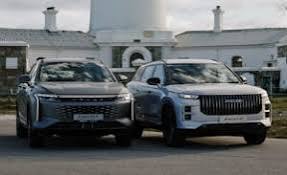Over the past decade, South Africa’s automotive market has undergone a remarkable transformation—and at the forefront of this shift is the dramatic rise of Chinese car manufacturers. Once considered fringe players in the industry, Chinese brands have now carved out a major presence on South African roads, offering modern design, feature-rich models, and unbeatable affordability. Leading the charge is Haval, the flagship SUV brand of Great Wall Motors (GWM), which has seen unprecedented growth in sales and popularity.
From initial skepticism to record-breaking market penetration, Chinese carmakers are not just surviving—they’re thriving. This article explores why Chinese automotive brands, particularly Haval, are capturing the South African imagination and what it means for the local industry moving forward.
From Curiosity to Contender
Ten years ago, spotting a Chinese car on South African roads was rare. Early models were often criticized for their uninspiring styling, questionable quality, and lack of aftersales support. However, the landscape has changed dramatically.
Haval launched in South Africa in 2017 and has quickly built a solid reputation for affordable, stylish, and well-equipped SUVs. Models like the H2, Jolion, and H6 have become top sellers, with consumers increasingly favoring them over more expensive rivals from Japan, Korea, and even Europe.
What began as cautious interest has now evolved into full-fledged enthusiasm, with monthly sales figures showing consistent growth, especially in urban centers like Johannesburg, Cape Town, and Durban.
Why South Africans Are Buying Chinese Cars
Several key factors explain the rapid adoption of Chinese cars in South Africa:
1. Value for Money
Chinese vehicles are significantly cheaper than their Western or Japanese counterparts, often by tens of thousands of rands. Yet they still offer:
- Advanced infotainment systems
- Panoramic sunroofs
- Driver assistance technology
- Leather interiors
This makes them highly appealing in a price-sensitive market.
2. Attractive Financing and Warranty Packages
Manufacturers like GWM and Chery have partnered with local banks to offer competitive financing terms, making it easier for first-time buyers to own a brand-new car. Extended warranty and service plans also add peace of mind.
3. Improved Build Quality
Recent Chinese models show marked improvements in materials, safety ratings, and engineering. Many are now manufactured or assembled with global standards in mind, targeting export markets beyond China.
4. Aggressive Marketing and Local Presence
Haval and its competitors have heavily invested in brand awareness and dealer networks. Their showrooms are now in virtually every major city, offering comprehensive aftersales service and support.
The Most Popular Chinese Models in SA
Haval Jolion
The Jolion has quickly become one of the top-selling compact SUVs in the country. With bold design, a luxurious interior, and a price tag starting under R350,000, it rivals models like the Hyundai Creta and Kia Seltos.
Haval H6
The H6 caters to families and long-distance travelers. It’s loaded with high-end tech and comes with a turbocharged engine—at a fraction of the price of its Western counterparts.
Chery Tiggo 4 Pro
Chery’s return to the market has been well-received, with the Tiggo 4 Pro praised for its sporty styling, infotainment system, and fuel efficiency.
BAIC X55 and BJ40
BAIC is another Chinese brand making waves. The X55 targets the entry-level SUV segment, while the BJ40 is a rugged off-roader aimed at enthusiasts who want a Jeep-like experience without the high cost.
Market Impact
According to NAAMSA (the National Association of Automobile Manufacturers of South Africa), Chinese carmakers have grown their market share from under 1% in 2016 to over 8% by the end of 2024. That’s an astonishing jump, especially in a market traditionally dominated by Toyota, Volkswagen, and Ford.
This rise has put pressure on older brands to rethink their pricing strategies and innovation pipelines. In some segments, Chinese models are now the benchmark for features and value, rather than the outliers.
Dealerships are also seeing the shift: many multi-brand dealers report that Chinese vehicles now account for a growing percentage of monthly sales, especially in entry and mid-level categories.
Jobs and Local Investment
Beyond selling cars, Chinese automakers are investing in local manufacturing and assembly. GWM has opened discussions around expanding its parts distribution and possibly establishing a South African assembly plant, which would bring jobs and local sourcing opportunities.
Such moves align with the South African government’s push to localize automotive production and reduce dependency on imports. In the long run, this could transform South Africa into a regional hub for Chinese vehicle production.
Challenges and Skepticism
Despite the positive momentum, not all feedback has been glowing. Concerns persist around:
- Long-term durability of certain models
- Spare parts availability in rural areas
- Resale value still lagging behind mainstream brands
However, Chinese brands are addressing these issues head-on—expanding parts warehouses, building brand loyalty, and offering long warranties to ease concerns.
The Road Ahead
The trajectory of Chinese carmakers in South Africa shows no signs of slowing down. With upcoming electric vehicle (EV) models, increased dealer presence, and an aggressive push into the mid- and upper-range segments, Chinese brands are set to reshape South Africa’s automotive future.
As EV infrastructure improves and consumer habits shift toward more connected, tech-savvy driving experiences, brands like BYD, Ora, and GAC may also enter the market, expanding choices for local drivers.
Conclusion
Once underestimated, Chinese carmakers are now commanding respect in South Africa’s auto industry. Through sharp pricing, rapid innovation, and a commitment to quality, they have proven that they’re not just here to participate—they’re here to lead.
South Africans, faced with rising living costs and evolving mobility needs, are embracing these brands not as compromises, but as smart, stylish, and sensible choices. Whether you’re a student buying your first car or a family upgrading to a spacious SUV, a Chinese model is likely on your shortlist.
This is more than a trend—it’s a new chapter in South African motoring.

Leave a Reply